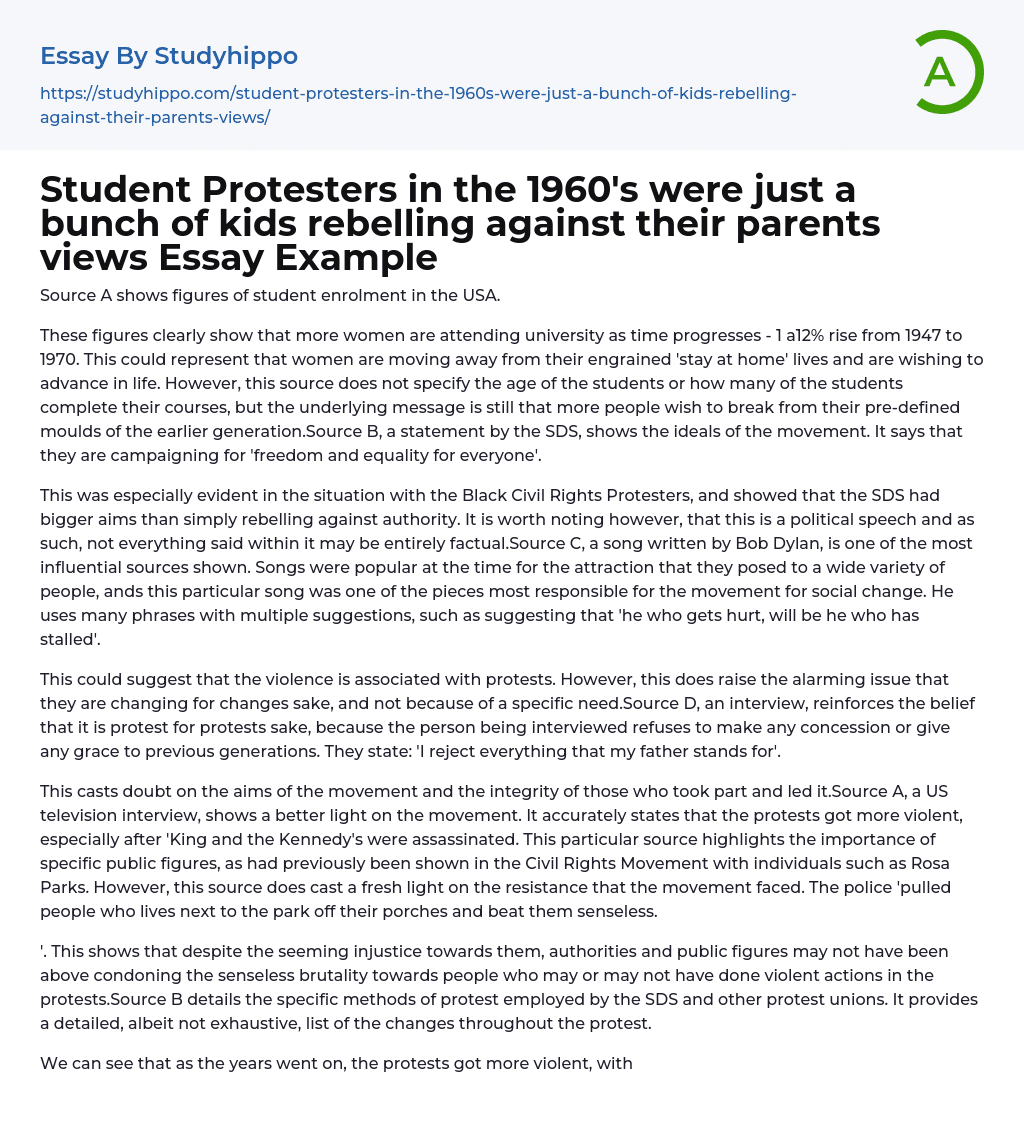Source A shows figures of student enrolment in the USA.
These figures clearly show that more women are attending university as time progresses - 1 a12% rise from 1947 to 1970. This could represent that women are moving away from their engrained 'stay at home' lives and are wishing to advance in life. However, this source does not specify the age of the students or how many of the students complete their courses, but the underlying message is still that more people wish to break from their pre-defined moulds of the earlier generation.Source B, a statement by the SDS, shows the ideals of the movement. It says that they are campaigning for 'freedom and equality for everyone'.
This was especially evident in the situation with the Black Civil Rights Protesters, and showed that the SDS had bigger
...aims than simply rebelling against authority. It is worth noting however, that this is a political speech and as such, not everything said within it may be entirely factual.Source C, a song written by Bob Dylan, is one of the most influential sources shown. Songs were popular at the time for the attraction that they posed to a wide variety of people, ands this particular song was one of the pieces most responsible for the movement for social change. He uses many phrases with multiple suggestions, such as suggesting that 'he who gets hurt, will be he who has stalled'.
This could suggest that the violence is associated with protests. However, this does raise the alarming issue that they are changing for changes sake, and not because of a specific need.Source D, an interview, reinforces the belief that
it is protest for protests sake, because the person being interviewed refuses to make any concession or give any grace to previous generations. They state: 'I reject everything that my father stands for'.
This casts doubt on the aims of the movement and the integrity of those who took part and led it.Source A, a US television interview, shows a better light on the movement. It accurately states that the protests got more violent, especially after 'King and the Kennedy's were assassinated. This particular source highlights the importance of specific public figures, as had previously been shown in the Civil Rights Movement with individuals such as Rosa Parks. However, this source does cast a fresh light on the resistance that the movement faced. The police 'pulled people who lives next to the park off their porches and beat them senseless.
'. This shows that despite the seeming injustice towards them, authorities and public figures may not have been above condoning the senseless brutality towards people who may or may not have done violent actions in the protests.Source B details the specific methods of protest employed by the SDS and other protest unions. It provides a detailed, albeit not exhaustive, list of the changes throughout the protest.
We can see that as the years went on, the protests got more violent, with occupation and destruction of building in particular being a specific method that came into popular use. The benefit of doing such things other than to draw attention to the union in a negative light is unclear, although it should be noted that not all of the protesters chose to take part in such direct activities.
This is shown in Source C, from America Divided: the Civil War of the 1960's , where people like Tom Hayden encourages people to protest with 'Viet Cong' placards or flags proclaiming their disdain for the war. However, Source C also shows the continuing trend that by the mid 1960s, violence had spiralled out of hand and protesters called for people to 'Stand in front of a troop train'.In conclusion, it could be seen that the aim of the Student Protests in the 1960s was well laid out and organized to focus on anti-war or pro-love tactics, but as the years progressed it quickly became a reality where violence was common and protests meant little except loss of life.
- Malala essays
- Activism essays
- Communism essays
- Conservatism essays
- Liberalism essays
- Marxism essays
- Nationalism essays
- Patriotism essays
- Policy essays
- Public Policy essays
- Social Contract essays
- Socialism essays
- Totalitarianism essays
- Abolitionism essays
- Adam Smith essays
- American History essays
- American Revolution essays
- Ancient Egypt essays
- Articles Of Confederation essays
- Atlantic Slave Trade essays
- Aztec essays
- Benjamin Franklin essays
- Civil Rights Act of 1964 essays
- Civil Rights Movement essays
- Civil war essays
- Cleopatra essays
- French And Indian War essays
- Gettysburg essays
- Great Depression essays
- Hurricane Katrina essays
- Industrial Revolution essays
- Jamestown essays
- Manifest Destiny essays
- Mccarthyism essays
- Patrick Henry essays
- Pearl Harbor essays
- Pocahontas essays
- Prohibition essays
- Pyramids essays
- Salem Witch Trials essays
- Slavery essays
- The New Deal essays
- Thirteen Colonies essays
- Westward Expansion essays
- Adoption essays
- Aunt essays
- Babies essays
- Bedroom essays
- Caring essays
- Children essays




